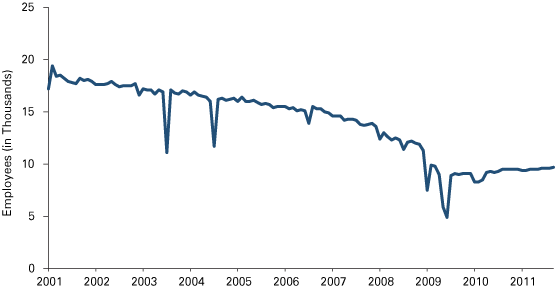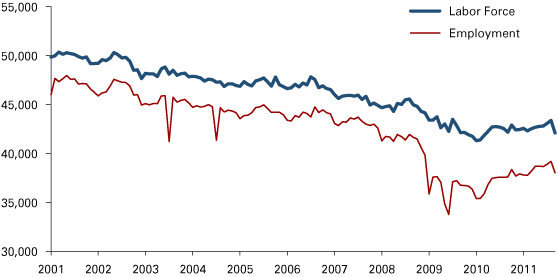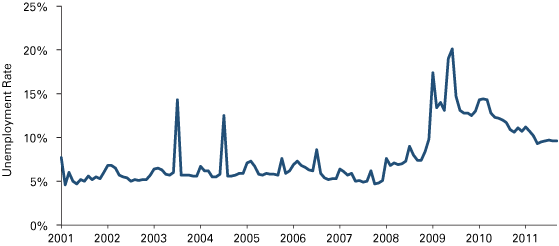Kokomo Forecast 2012
Professor of Economics, Indiana University Kokomo
While Kokomo is celebrating a new laboratory at Delphi and the Indiana Chamber of Commerce naming it as the ”Community of the Year,” its economy still remains heavily weighted toward manufacturing. Employment in manufacturing industries peaked statewide in June 2000, and while recent losses have been much less than they were in 2009 (with some months even posting gains), manufacturing employment has still not regained anywhere close to its peak (see Figure 1).
Figure 1: Manufacturing Employment in Kokomo, January 2001 to September 2011

Source: IBRC, using Bureau of Labor Statistics data
The Kokomo area remains heavily invested in industrial production and is very subject to economic disruptions as industrial production fluctuates. The critical news is that many of these job losses will be permanent due to increasing productivity, job losses to overseas and the troubles in the automobile industry. This means that manufacturing production, while increasing somewhat, is unlikely to return to the glory days of the past.
Overall, Kokomo’s labor force (defined as those employed and those seeking employment) is smaller than in 2001. The decrease in the labor force numbers from 50,000 in 2001 to 42,500 in 2011 means that there are clearly fewer people in the area. Employment has also decreased in that same 10-year time period (see Figure 2).
Figure 2: Labor Force and Employment in Kokomo, January 2001 to September 2011

Source: IBRC, using Bureau of Labor Statistics data
The unemployment rate, while still higher than the state average, is nowhere near the highs of a few years ago (see Figure 3). In the data collected by the Bureau of Labor Statistics, many industries are showing a slight increase in employment.
Figure 3: Kokomo’s Unemployment Rate, January 2001 to September 2011

Source: IBRC, using Bureau of Labor Statistics data
Even if job growth is occurring, it is not in the same high-paying industries that drove the Kokomo economy for so long. This has an impact on stores, restaurants, etc. since the buying habits of workers making $800 per week may not be equivalent to those earning $1,640 per week. Economic theory says that the lower-paid workers may dine out less, buy less clothing (or buy clothing at less expensive stores), travel less, buy less expensive electronics, etc. Therefore, retailers, restaurateurs, etc. need to be aware of these trends and plan accordingly.
There are some bright spots—agriculture continues to do reasonably well. The high dollar values for corn and soybeans make commodity farmers very happy (though it doesn’t make the livestock farmers nearly as happy). There are new businesses starting in the area, and Indiana has had some success in attracting new large business operations.
Nevertheless, the gloominess that has pervaded the economy for several years now continues. Overall, growth for the Kokomo economy is iffy. Trends in the automobile and other manufacturing industries will need to be watched carefully and local authorities will need to remain proactive on preparing the community for the future. In particular, K-12 students need to be reminded that their futures lie in industries very different from those of their parents and that they need to acquire the skills needed for that future.
Also in this Issue…
- Outlook for 2012
- International Outlook for 2012
- U.S. Outlook for 2012
- Financial Outlook for 2012
- Housing Market Outlook for 2012
- Indiana's Outlook for 2012
- Indiana's Agricultural Outlook for 2012
- Anderson Forecast 2012
- Bloomington Forecast 2012
- Columbus Forecast 2012
- Evansville Forecast 2012
- Fort Wayne Forecast 2012
- Gary Forecast 2012
- Indianapolis-Carmel Forecast 2012
- Kokomo Forecast 2012
- Lafayette Forecast 2012
- Louisville Forecast 2012
- Muncie Forecast 2012
- Richmond Forecast 2012
- South Bend and Elkhart Area Forecast 2012
- Terre Haute Forecast 2012




